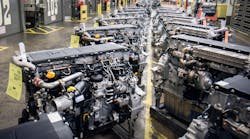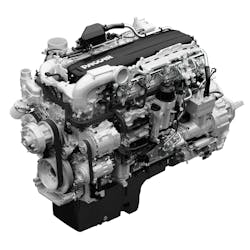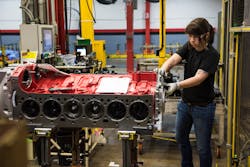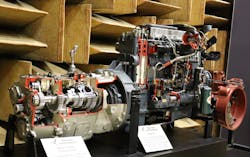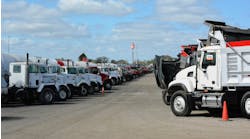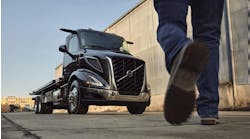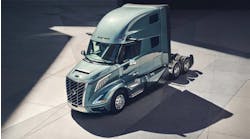There’s always a certain amount of pressure on fleets and owner-operators to “get it right” when spec’ing a new truck. In a business with such slim margins, a slight miscalculation can snowball into a mountain of money lost over the life of a Class 8 tractor.
Some boxes are fairly easy to tick, like a sleeper versus day cab, based on application, be it regional or long-haul, or vocational.
But that’s not always the case. Previously, FleetOwner discussed how something like choosing the most optimal low rolling resistance tires can save several thousands of dollars or more, but nothing impacts overall performance of a fleet more than the diesel engine. This is the general premise of engine rightsizing, which traditionally can mean dropping down in engine displacement, sometimes even down in vehicle class, to increase efficiency and not have more power than necessary.
‘No replacement for displacement’
In the heavy-duty segment, the first question to answer is how big should the engine be, or rather what is the displacement?
Displacement is measured by the diameter of the pistons or bore. Currently for Class 8 trucks, at the lower end, this is around 10L to11L, around 12L to13L for midrange, and around 15L at the high end. Usually, the number designation approximates the displacement volume. Paccar’s MX-13 is 12.9L while Detroit Diesel’s DD13 is 12.8L. This is not always the case, however, as the Mack Trucks MP8 is 13L.
Simply put, the higher the displacement, the more the power. Fleets needing more power (construction, off-high-way, heavy haul, varied elevations) have veered toward higher displacement engines, but current technology has allowed fleets to have more options and a more equitable compromise between performance and fuel and operational efficiencies.
The load requirements for a truck are a jumping-off point.
“If you’re going to be doing anything over 80,000 lb., you’re not going to want to look at a DD13 engine. You’re going to want to look at a DD15 engine,” explained Len Copland, product marketing manager for Detroit Products at Daimler Trucks North America. “I had a former boss who always used to say, ‘There’s no replacement for displacement.’”
But Copeland also said there are many factors to consider when spec’ing a new engine — from B50 life rating, a measurement for engine life expectancy; weight; resale value; and fuel economy.
“We need to help educate not only our dealers that are selling trucks but also customers that are buying trucks, because the evolution of our technology has really come a long way,” Copeland advised.
While the DD13 and DD15 have similar horsepower and torque ratings, they do perform differently, and fleets will pay more for the bigger engine, Copeland said.
When spec’ing any engine, fleets also must consider the annual mileage and duty cycle. Copeland said trucks that travel more than 80,000 miles annually should consider a DD15, while under should go with the DD13.
“The DD15 was designed with downspeeding as a critical part of its set-up with a fully integrated Detroit Powertrain,” Copeland said. “With a 400-hp DD15 and an aggressive rear axle ratio, peak torque today is reached well below 1,000 rpms, which is 500-600 rpm lower than we would see a handful of years ago.”
Copeland noted the lower the engine rotations, the less fuel is consumed.
Along with saving at the pump, a higher displacement engine will require less maintenance due to a concerted effort to lengthen maintenance intervals.
The higher displacement means more robust components that are designed to last longer and require less frequent maintenance. One such area is the diesel particulate filter. With the redesigned DD15 Gen 5, the aftertreatment does not cool down during coasting, which shortens the regeneration cycle and reduces ash buildup. “We keep the heat in the exhaust stream, so that regeneration keeps going,” Copeland said.
Jacob White, Peterbilt’s director of product marketing, has seen Paccar customers moving away from X-15 en-gines from Cummins and toward Paccar’s MX-13 and MX-11.
“The 15L was kind of industry standard for a long time, but 12 and 13L engines have really proved that they’re able to do the job very efficiently with great longevity and reliability,” White said. “Since we launched the MX-13 in North America back in 2010, it’s really grown in that on-highway (segment). Our customers who were running the [Cat] C15 engine or [X15 predecessor] ISX15 engine have migrated to the MX-13 for its efficiency as well as weight.”
The MX-13 is 400 lb. lighter than a 15L engine, and the MX-11 drops an additional 400 lb. This allows a bulk material trans-porter, for example, to haul more payload. The MX-11 is typically used for regional haul, vocational, and refuse applications, while the MX-13 can be employed in those applications as well as over-the-road and heavy-haul duty cycles.
Petroleum hauler DB Trucking in Florida specs Kenworth T880 day cabs with the MX-11 (415 hp and 1,550 lb.-ft. of torque) and 10-speed transmission.
“We don’t run our engines full-tilt,” owner Dan Marando said. “We have them dialed back to around 400 hp. I’m a firm believer that a conservative approach creates longevity and less wear and tear on the engines. They’re also geared properly so that they’re not overrun.”
White compared the Paccar MX-13 to a “Swiss Army knife” because of its versatility.
“A lot of times — right now more than ever — fleets are looking at different avenues of business to grow, and so that adaptability is very important,” he said. “The worst thing you can do is spec a truck for one job and not be able to do any others.”
In those cases, fleets might want to get the more flexible powertrain.
To cater to its customers wanting flexibility, Cummins released the 11.8L X12 in 2018 as an option for both its regional haul and vocational customers.
“The X12 has a higher rpm capability than many of the existing on-highway products, but the new design trimmed down the weight of the engine and after-treatment by 650 lb., which makes it now the lightest engine over 10L on the market. The low-friction design also reduced parasitic losses for a 6% bump in fuel economy,” said Kris Ptasznik, Cummins product manager for the heavy-duty on-highway segment.
Ptasznik added a Cummins X12 or X15 engine integrated with an Eaton Endurant transmission can “offer the lowest total cost of ownership and greatest maintenance intervals, so equipment can stay on the road making money.
When it is an option, customers should look beyond the sticker price and in-stead focus on cost over time.”
The U.S. Environmental Protection Agency’s Greenhouse Gas Emissions Phase 2-compliant 2021 X15 Efficiency Series was designed for 75,000-mile oil drain intervals for trucks averaging 7-plus mpg. Through the Cummins Oil-Guard oil analysis program, that can be pushed to 100,000 miles.
That integrated powertrain also can boost safety. All X-Series now offer drivability features including onramp boost, predictive engine braking, predictive gearshift, and dynamic power.
Along with the X15, Navistar Inter-national LT Series customers can also choose the A26 Big Bore engine, which the OEM launched in 2017. The 12.4L engine ranges from 365-500 hp and provides a more modest option that weighs 2,299 lb., which is 27% less than the X15 Productivity Series and 22% less than the Efficiency Series.
Less is more
After finding the optimal displacement, the next thing to figure out are the proper horsepower and torque ratings. According to Johan Agebrand, director of product marketing at Volvo Trucks, the “sweet spot” is roughly 400 to 425 hp for trucks with 70,000-80,000 lb. GVWR and 1,750 lb.-ft. of peak torque.
Geography matters, though, Agebrand explained. If fleets run more in the flatter Midwest, 400 hp is sufficient, though along the rougher terrain of the Northeast or Rockies, 455 hp would be a better rating. A dump truck that constantly climbs out of steeply graded gravel pits would need 500 hp, though, Agebrand said.
“It’s going to come down to re-ally understanding your route and where you are going to run.
And then the OEM can help you with what that means,” he added, advising not to overestimate or under-estimate.
Automatic manual transmissions have helped push horsepower requirements down. “AMTs have changed how we can design the engine,” Agebrand explained. “The engine doesn’t need to be really heavy on torque or horsepower in the high rpm range any-more; the only occasion we drive there is while going downhill, when you will rev it up a little bit to get the most engine braking power you can get.”
When spec’ing, Agebrand advised to not overestimate how much power is needed. He said while fleets may often spec 425 hp, that much power could be excessive and that “a lot of people could live with a 405 hp.” It does truly depend on the application, though. A flatbed operation would still require a 455 hp, as it cannot employ friction-reducing technology such as trailer aero kits and need that extra oomph.
One trend the adoption of AMTs allowed for is downspeeding. This refers to the speeding up of the rear gear ratio to lower the engine speed, allowing the engine to achieve a truck’s most efficient rpm with the lowest horsepower to maintain a cruise speed of 65 mph. According to the North American Council for Freight Efficiency, downspeeding can cut a truck’s fuel cost by up to 3%.
Agebrand said except for the D11, all of Volvo Trucks’ diesel engines are downsped. The D13TC (turbo compound) engine, launched in 2017 and updated in 2020, has taken advantage of this technology, improving fuel efficiency by 11% versus 2015 model year trucks.
“This new D13TC builds upon this game-changing engine technology, further increasing fuel efficiency by up to 3% over the current D13TC engine, saving approximately $1,200 per year per truck, based on the average fuel price and 125,000 miles per year,” said John Moore, product marketing manager at Volvo Trucks North America.
Copeland mentioned that Detroit Diesel has also greatly dropped their ratios. In 2007, the company recommended a direct drive engine with a 3.08 rear axle ratio and in 2014 one with a 2.47 rear axle ratio. A Freightliner Cascadia with the latest DD15 and DT12 overdrive transmission can now have a 2.16 rear axle ratio. Typically, efficiency boosts degrade performance, but because of how the engine manages the power, 1,150 rpm falls within the torque curve.
Cummins also uses downsped engines, though Ptasznik had some critical factors to consider.
“If a pickup and delivery or regional haul customer took the most aggressive downsped axle ratio recommended for a strictly linehaul customer, the end result won’t meet their expectations,” he explained. “Fleets should work with their local supplier representative when making changes to traditional specs.
“Other things to consider are time spent on soft surfaces, what the typical operation looks like versus the top desired speed, what typical GVW looks like compared to the maximum the fleet runs, and what spec their drivers are used to,” Ptasznik continued. “Making drastic changes can quickly increase fuel economy but can also just as quickly create other issues within the overall business.”
Drivability
Research and analysis, internal discussions with managers and drivers, and meetings with dealers should all take place, as with any major equipment decision, but the big thing to remember is the learning should never stop.
“Because of how technology changes rapidly, even within the same platform and through different generations, it requires just constant education for your driving team,” said Phil Taylor, vice president of fleet maintenance for Central Oregon Truck Co.
This Daseke-owned company based in Redmond, Ore., was named Best Small Fleet to Drive For by the Truckload Carrier’s Association and CarriersEdge in 2018 and has made the list eight times, most recently in 2021.
This Kenworth-exclusive flatbed fleet operates in the lower 48 U.S. states and three Canadian provinces. The majority of its T680 tractors operate under 80,000 lb. GVWR and use a Paccar MX-13 engine rated at 455 hp and 1,650 lb., though around 50 trucks pull up to 105,000 lb. and use an MX-13 rated at 510 hp and 1,850 lb.-ft. Taylor also oversees Leavitt’s Freight Service, a fleet of 120 Kenworth and Freightliner trucks acquired by Central Oregon Truck Co. in 2018.
By and large, these two fleets use integrated powertrains, meaning the engine, transmission, and sometimes axles come from the same OEM to unlock additional efficiency benefits. Taylor said he’s a “big believer in vertical integration, so when possible, we incorporate that concept when we can.”
“I always look for a balance between drivability and efficiency,” Taylor explained. “You can never give a truck driver enough horsepower, but you have to build in a high level of efficiency as well. We could go big horse-power, with a higher displacement engine, which, you know, is going to promote drivability but potentially have an adverse effect on your operating efficiency.”
He said whatever the decision, the drivers need to buy into what the fleet is trying to achieve.
Taylor said his fleet switched from the 15L offering from Detroit and Cummins prior to the launch of the MX13 a decade ago. “There was an adjustment period to go from a 13L displacement,” he acknowledged.
Cowen Truck Line in Ohio, a fleet of 60 Kenworth T680s and T880s running Cummins X15 engines (450 hp, 1,550/1,750 lb.-ft. at 1,000 rpm) that puts an emphasis on optimal fuel performance, has found a successful solution. They are paired with the Eaton Endurant.
“Predictive cruise control is integrated with a neutral coast function in the trans-mission,” company president Tim Cowen said. “During downhill driving, this enhances fuel economy by knowing when to re-engage the powertrain and use the engine brake to control speed. Using this system, Cowen Truck Line has seen a 15% increase in overall mpg.”
Drivers have embraced the focus on fuel because they receive bonuses based on fuel efficiency, said company president Tim Cowen.
“Drivers like the efficiency of the Cummins engine because they are able to achieve optimal fuel mileage and bonuses while having optimal torque,” Cowen said. And by going easy on the engine, Cowen noted maintenance costs are lower as well.
The key is to simply communicate and make the drivers part of the discussion and to pass on why a new engine may be a better fit for the fleet, even if it’s not what they are used to.
“As an industry, we frequently stumble when we move technology out to our driving community, and we don’t educate them regarding how things should operate, what’s going to happen, and what’s in it for them,” Taylor said. “Continuing education for your drivers is very, very important."
